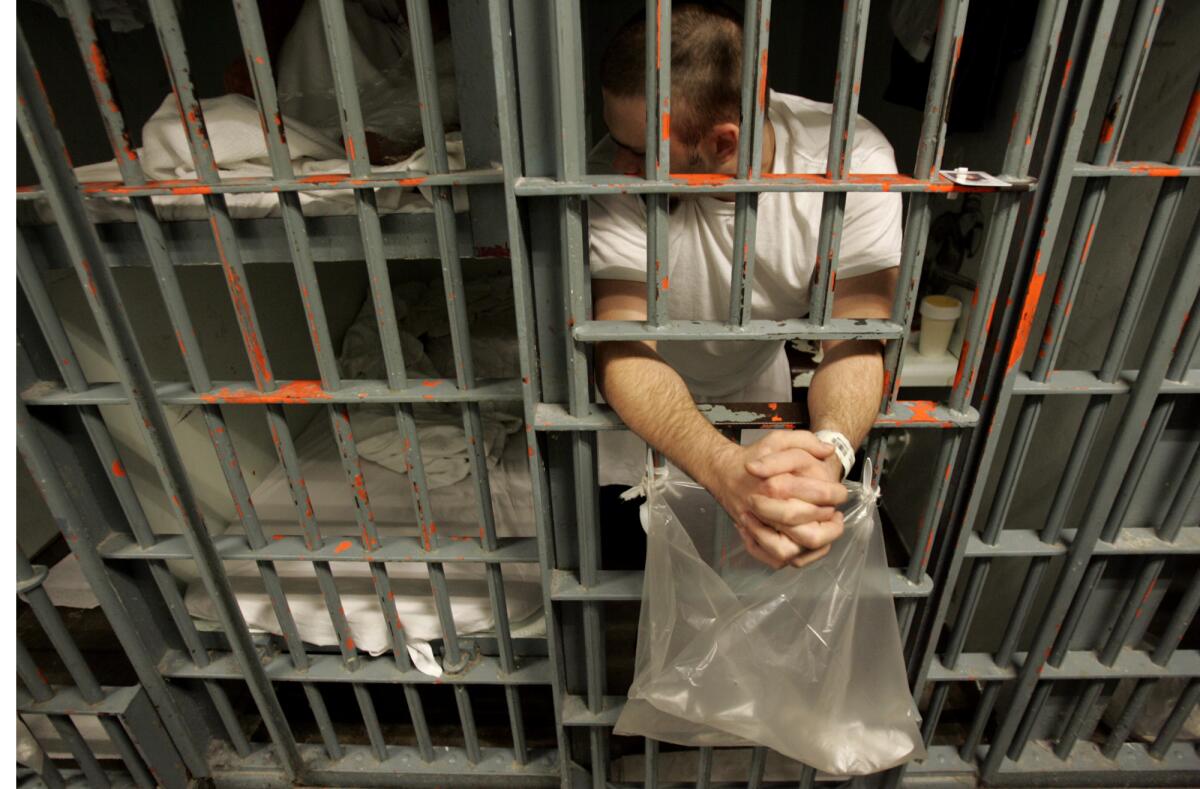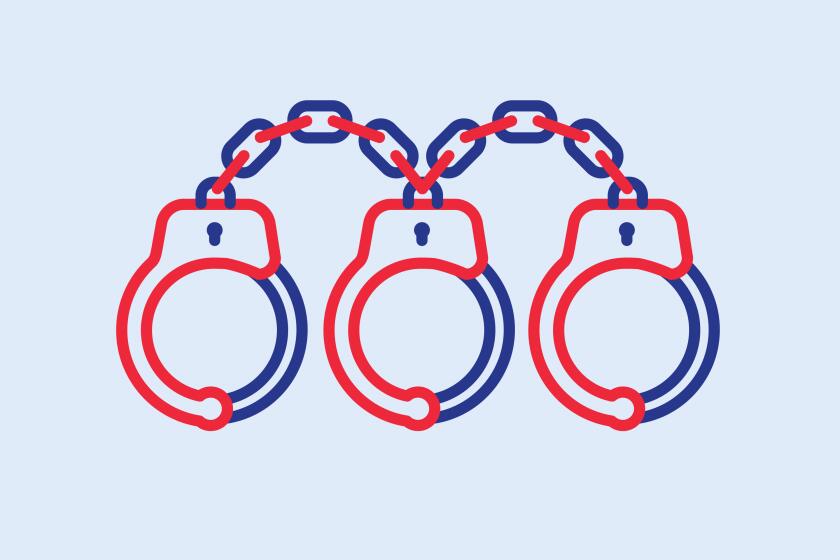What exactly is Prop. 47? And how could California voters change it this year?

California voters face a decision about how the state should punish people who are repeatedly convicted of stealing, or of crimes involving the deadly drug fentanyl. Proposition 36 on the November ballot asks voters to change certain parts of Proposition 47, an initiative passed in 2014 that turned some nonviolent felonies into misdemeanors.
Here’s what you need to know about how this year’s measure, if passed, would change the law Californians approved a decade ago.
Why did Proposition 47 happen?
In May 2011, a U.S. Supreme Court upheld a decision against the state of California that required reducing the prison population to avoid overcrowding. A federal three-judge panel had ordered every state prison in California to reduce its population to 137.5% of its “design capacity” within two years. In the 2010s, the state’s prisons were functioning at over 180% capacity, which meant they were holding about 34,000 inmates over the limit established by the federal court.
State lawmakers approved legislation that changed how the state prosecuted low-level, non-serious offenses, referred to as “realignment,” allowing some offenders to serve their time in county jails rather than state prisons.
Liberal advocacy groups pushed for Proposition 47 as another way to reduce the prison population and direct more money to drug treatment and victim services.
How did Proposition 47 in 2014 change California law?
Proposition 47 had three major components: reducing some felonies to misdemeanors; allowing prisoners to have their sentences reduced if they were serving time for crimes that were reduced to misdemeanors; and shifting money saved from reduced incarceration to services in local communities.
Proposition 47 reclassified some felony crimes and made it so individuals who commit certain nonviolent drug and property crimes, including shoplifting where merchandise under $950 was stolen and simple drug possession, would be sentenced on misdemeanor charges instead of felony charges. Though prosecutors filed misdemeanor charges for many of those crimes before Proposition 47 was enacted, some had been considered a “wobbler” and could be charged as either a misdemeanor or a felony. A misdemeanor sentence would still lead to a person serving up to a year in county jail. Proposition 47 did not apply to people who already had a prior conviction for serious or violent crimes, and it did not apply to registered sex offenders.
Proposition 47 has allowed more than a million people to reduce old, low-level, non-violent felonies on their record to misdemeanors. But the mechanism to do that under Proposition 47 expired in November 2022, according to the state Judicial Council, and state law only allows people to apply later if they can show a “good cause.” The criminal justice advocacy group Californians for Safety and Justice, which was one of the major proponents of the measure, said that thousands of prisoners are estimated to still be eligible for resentencing, and a bill is expected to be voted on this August that would extend the deadline indefinitely.
The measure passed by more than 1.3 million votes. Notable supporters at the time included social justice organizations such as Californians for Safety and Justice and the American Civil Liberties Union, and it was largely funded by five major philanthropic foundations including the Rosenburg Foundation, a Bay Area social justice organization, George Soros through his Open Society Foundation and the Ford Foundation. Opponents of the measure included the California Police Chiefs Assn. and other law enforcement groups and district attorneys from Alameda and Contra Costa counties, as well as former Assemblyman Jim Cooper, who is now the Sacramento County Sheriff.
Since 2014, the state has saved about $100 million annually resulting from the sentencing changes made under Proposition 47. Those funds have gone to victim services, mental health, and substance use services.
This measure asks voters to change parts of Proposition 47, a controversial ballot initiative passed in 2014 that turned some nonviolent felonies into misdemeanors.
What is the difference between a misdemeanor and a felony?
A misdemeanor is less serious than a felony. Typically people convicted of a misdemeanor will serve out their sentence in a county jail for a maximum of one year. In California, county jails are overseen by the local sheriff’s department. Other forms of punishment for a misdemeanor conviction include being under the supervision of a probation officer or a fine.
A felony is defined as a violent or serious type of crime. These crimes can include murder, robbery, or rape. People convicted of felonies can be sentenced to county jail and community supervision, or to state prison.
How would this year’s Proposition 36 change things?
Proposition 36 would impose mandated drug treatment for some drug crimes, add new penalties for some theft and drug offenses and add new sentencing enhancements that would apply to any crime.
Drugs
Possession for personal use of illegal drugs is usually charged as a misdemeanor. The ballot measure would add fentanyl to a list of hard drugs, such as heroin, cocaine, or methamphetamine that are already considered a felony depending on the amount that is sold or if they are armed with a firearm while trafficking the drugs. Fentanyl is a synthetic opioid that is 100 times more potent than morphine and is used to treat severe pain under the supervision of a licensed medical professional. In recent years, illegal forms of fentanyl have been smuggled into the U.S., and other more common street drugs like cocaine have been known to be laced with lethal doses of the drug. These drug-related deaths have increased in California, and 3,946 people are known to have died from fentanyl overdose in 2020 in California alone.
Under Proposition 36, a judge could sentence someone possessing any amount of hard drugs, if the person has already been convicted of two or more drug-related offenses, to up to three years in state prison. The measure allows the judge to determine if a person is eligible for treatment and can participate in a treatment-mandated felony instead of incarceration.
If a person successfully completes drug treatment, their charges would be dismissed.
The ballot measure also allows judges to sentence convicted drug dealers who traffic in large quantities of hard drugs, including fentanyl, or who are armed with a firearm while trafficking the drugs, to state prison instead of county jails. It would also make it a felony the fourth time that someone is found in possession of such drugs and is also found in possession of a firearm. Current law calls for felony charges in these situations for a shortlist of drugs. The measure would add fentanyl to that list.
Proposition 36 also would authorize greater consequences for hard drug dealers whose sales of fentanyl kill or seriously injure a person who uses those drugs. It would authorize a judge to warn convicted dealers that they could be charged with murder in the future if someone dies as a result of the drugs they sold.
Theft
Under Proposition 36, the theft of money or property worth $950 or less would be punishable as a felony for people who have two or more previous convictions for some theft-related crimes. It also would allow prosecutors to file felony charges if a person is accused of multiple thefts that add up to a dollar figure over $950. Previous theft convictions can also count. If someone has two misdemeanor property theft charges on their record from years ago, and then steals again, for the third time, after Proposition 36 is enacted, they can also be eligible for a felony charge.
Costs
Proposition 47 has helped the state save nearly $100 million a year on prison spending, and in turn, distributed the money to victim services and reentry programs. Those savings would likely be reduced, the nonpartisan Legislative Analyst’s Office wrote in an analysis, if more people become incarcerated under the new ballot measure. That would mean fewer dollars will be allocated to those public services.
The analyst’s office also said that the state would see an increase in costs in two other ways: The first is that it would require some people who now serve their sentences at the county level to serve them in state prison, increasing the prison population by a few thousand people. The second is the cost of increased workload, given the extra time it takes for courts to resolve felonies and to facilitate treatment-mandated felonies.
What parts of Proposition 47 would remain in place if voters pass Proposition 36?
Drugs
Before Proposition 47, if you carried drugs of any weight, otherwise known as simple drug possession, it could have been considered either a felony or a misdemeanor. When Proposition 47 passed, simple drug possession became a misdemeanor. Under Proposition 36, a person would still be charged with a misdemeanor for the first two simple drug possession convictions but on the third conviction, a person would be charged as a felony and qualify for jail or prison time.
Theft
Since Proposition 47, any nonviolent property theft under $950 is generally charged as a misdemeanor.
Under Proposition 36, the first two thefts under $950 would remain a misdemeanor — which is similar to Proposition 47 — but a person’s third theft conviction, regardless if under $950 was stolen, would qualify as a felony and make a person eligible for prison time.
Resentencing
Proposition 36 doesn’t explicitly change anything about resentencing rules, but policy analysts have raised the possibility that certain individuals wouldn’t be eligible for resentencing under the new measure.
More to Read
Sign up for Essential California
The most important California stories and recommendations in your inbox every morning.
You may occasionally receive promotional content from the Los Angeles Times.












